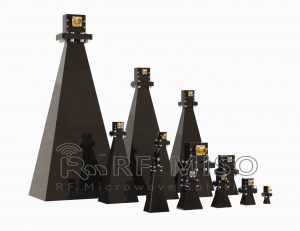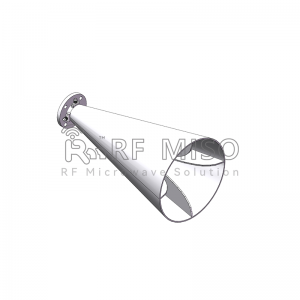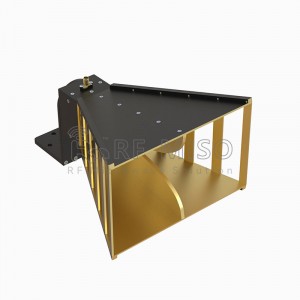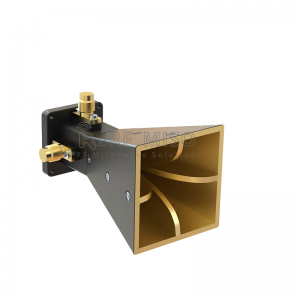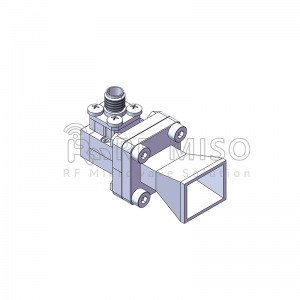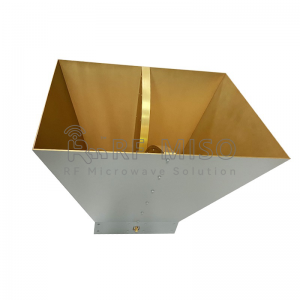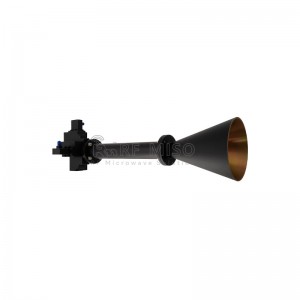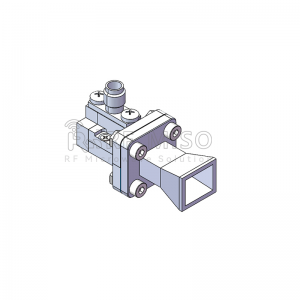Horn antenna is a surface antenna, a microwave antenna with a circular or rectangular cross-section in which the terminal of the waveguide gradually opens. It is the most widely used type of microwave antenna. Its radiation field is determined by the mouth size and propagation type of the speaker. Among them, the influence of the horn wall on radiation can be calculated using the principle of geometric diffraction. If the length of the horn remains unchanged, the size of the mouth surface and the quadratic phase difference will increase as the horn opening angle increases, but the gain will not change with the size of the mouth surface. If you need to expand the frequency band of the speaker, you need to reduce the reflection at the neck and mouth of the speaker; the reflection will decrease as the size of the mouth increases. The structure of the horn antenna is relatively simple, and the pattern is relatively simple and easy to control. It is generally used as a medium directional antenna. Parabolic reflector horn antennas with wide frequency range, low side lobes and high efficiency are often used in microwave relay communications.
The radiation field of the horn antenna can be calculated from the surface field using Huygens' principle. The mouth surface field is determined by the mouth surface size and propagation wave pattern of the horn. Geometric diffraction theory can be used to calculate the influence of the horn wall on radiation, so that the calculated pattern and the measured value can be in good agreement up to the far side lobe. Its radiation characteristics are determined by the size and field distribution of the mouth surface, while the impedance is determined by the reflection of the speaker's neck (the beginning discontinuity) and the mouth surface. When the length of the horn is constant, if the opening angle of the horn is gradually increased, the size of the mouth surface and the quadratic phase difference will also increase at the same time, but the gain does not increase simultaneously with the size of the mouth surface, and there is a gain with the maximum value. Mouth surface size, a speaker with this size is called the best speaker. Conical horns and pyramidal horns propagate spherical waves, while fan-shaped horns that open on one surface (E or H surface) propagate cylindrical waves. The surface field of the horn mouth is a field with a quadratic phase difference. The size of the quadratic phase difference is related to the length of the horn and the size of the mouth surface.
Horn antennas are commonly used in the following areas: 1. Feeds for large radio telescopes, reflective antenna feeds for satellite ground stations, and reflective antenna feeds for microwave relay communications; 2. Unit antennas for phased arrays; 3. Antennas In measurements, horn antennas are often used as a common standard for calibration and gain testing of other high-gain antennas.
Today I would like to recommend some horn antennas produced by RFMISO. Here are the specifics:
product description:
1.RM-CDPHA218-15 is a dual polarized horn antenna that operates from 2 to 18 GHz. The antenna offers a typical gain of 15 dBi and low VSWR 1.5:1 with SMA-F connector. It has linear polarization and is ideally applied for communication systems, radar systems, antenna ranges and system setups.
|
RM-CDPHA218-15 |
||
|
Parameters |
Typical |
Units |
|
Frequency Range |
2-18 |
GHz |
|
Gain |
15 Typ. |
dBi |
|
VSWR |
1.5 Typ. |
|
|
Polarization |
Dual Linear |
|
|
Cross Pol. Isolation |
40 |
dB |
|
Port Isolation |
40 |
dB |
|
Connector |
SMA-F |
|
|
Surface Treatment |
Paint |
|
|
Size (L*W*H) |
276*147*147(±5) |
mm |
|
Weight |
0.945 |
kg |
|
Material |
Al |
|
|
Operating Temperature |
-40-+85 |
°C |
2.RM-BDHA118-10 is a linear polarized broadband horn antenna that operates from 1 to 18 GHz. The antenna offers a typical gain of 10 dBi and low VSWR 1.5:1 with SMA-Female connector. It is ideally applied for EMC/EMI testing, surveillance and direction finding systems, antenna system measurements and other applications.
|
RM-BDHA118-10 |
||
|
Item |
Specification |
Unit |
|
Frequency Range |
1-18 |
GHz |
|
Gain |
10 Typ. |
dBi |
|
VSWR |
1.5 Typ. |
|
|
Polarization |
Linear |
|
|
Cross Po. Isolation |
30 Typ. |
dB |
|
Connector |
SMA-Female |
|
|
Finishing |
Paint |
|
|
Material |
Al |
|
|
Size |
174.9*185.9*108.8(L*W*H) |
mm |
|
Weight |
0.613 |
kg |
3.RM-BDPHA1840-15A is a dual polarized horn antenna that operates from 18 to 40 GHz, The antenna offers 15dBi typical gain. The antenna VSWR is typical 1.5:1. The antenna RF ports are 2.92mm-F connector. The antenna can be widely used in EMI detection, orientation, reconnaissance, antenna gain and pattern measurement and other application fields.
|
RM-BDPHA1840-15A |
||
|
Parameters |
Typical |
Units |
|
Frequency Range |
18-40 |
GHz |
|
Gain |
15 Typ. |
dBi |
|
VSWR |
1.5 Typ. | |
|
Polarization |
Dual Linear |
|
|
Cross Pol. Isolation |
40 Typ. |
dB |
|
Port Isolation |
40 Typ. |
dB |
|
Connector |
2.92mm-F |
|
|
Material |
Al |
|
|
Finishing |
Paint |
|
|
Size |
62.9*37*37.8(L*W*H) |
mm |
|
Weight |
0.047 |
kg |
4.RM-SGHA42-10 is a linear polarized standard gain horn antenna that operates from 17.6 to 26.7 GHz. The antenna offers a typical gain of 10 dBi and low VSWR 1.3:1. The antenna has a typical 3dB beamwidth of 51.6 degrees on the E plane and 52.1 degrees on H plane. This antenna has flange input and coaxial input for customers to rotate. Antenna mounting brackets include ordinary L-type mounting bracket and rotating L-type bracket
|
Parameters |
Specification |
Unit |
||
|
Frequency Range |
17.6-26.7 |
GHz |
||
|
Wave-guide |
WR42 |
|
||
|
Gain |
10 Typ. |
dBi |
||
|
VSWR |
1.3 Typ. |
|
||
|
Polarization |
Linear |
|
||
|
3 dB Beamwidth, E-Plane |
51.6°Typ. |
|
||
|
3 dB Beamwidth, H-Plane |
52.1°Typ. |
|
||
|
Interface |
FBP220(F Type) |
SMA-KFD(C Type) |
|
|
|
Material
|
AI | |||
|
Finishing |
Paint |
|
||
|
C Type Size (L*W*H) |
46.5*22.4*29.8 (±5) |
mm |
||
|
Weight |
0.071(F Type) |
0.026(C Type) |
kg |
|
|
C Type Average Power |
50 |
W |
||
|
C Type Peak Power |
3000 |
W |
||
|
Operating Temperature |
-40°~+85° |
°C |
||
5.RM-BDHA056-11 is a linear broadband horn antenna that operates from 0.5 to 6 GHz. The antenna offers a typical gain of 11 dBi and low VSWR 2:1 with SMA-KFD connector. The antenna is used for long time trouble-free applications in indoor and outdoor environments. It can be widely used in EMI detection, orientation, reconnaissance, antenna gain and pattern measurement and other applications.
|
RM-BDHA056-11 |
||
|
Parameters |
Typical |
Units |
|
Frequency Range |
0.5-6 |
GHz |
|
Gain |
11 Typ. |
dBi |
|
VSWR |
2 Typ. |
|
|
Polarization |
Linear |
|
|
Connector |
SMA-KFD(N-Female avillable) |
|
|
Finishing |
Paint |
|
|
Material |
Al |
|
|
Average Power |
50 |
w |
|
Peak Power |
100 |
w |
|
Size(L*W*H) |
339*383.6*291.7 (±5) |
mm |
|
Weight |
7.495 |
kg |
6.RM-DCPHA105145-20 is a dual circular polarized horn antenna that operates from 10.5 to 14.5GHz, The antenna offers 20 dBi typical gain. The antenna VSWR below 1.5. The antenna RF ports are 2.92-female coaxial connector. The antenna can be widely used in EMI detection, orientation, reconnaissance, antenna gain and pattern measurement and other application fields.
|
RM-DCPHA105145-20 |
||
|
Parameters |
Typical |
Units |
|
Frequency Range |
10.5-14.5 |
GHz |
|
Gain |
20 Typ. |
dBi |
|
VSWR |
<1.5 Typ. | |
|
Polarization |
Dual-Circular-polarized |
|
|
AR |
1.5 |
dB |
|
Cross polarization |
>30 |
dB |
|
Port Isolation |
>30 |
dB |
|
Size |
436.7*154.2*132.9 |
mm |
|
Weight |
1.34 |
|
7.RM-SGHA28-10 is a linear polarized standard gain horn antenna that operates from 26.5 to 40 GHz. The antenna offers a typical gain of 10 dBi and low VSWR 1.3:1. The antenna has a typical 3dB beamwidth of 51.6 degrees on the E plane and 52.1 degrees on H plane. This antenna has flange input and coaxial input for customers to rotate. Antenna mounting brackets include ordinary L-type mounting bracket and rotating L-type bracket
|
Parameters |
Specification |
Unit |
||
|
Frequency Range |
26.5-40 |
GHz |
||
|
Wave-guide |
WR28 |
|
||
|
Gain |
10 Typ. |
dBi |
||
|
VSWR |
1.3 Typ. |
|
||
|
Polarization |
Linear |
|
||
|
3 dB Beamwidth, E-Plane |
51.6°Typ. |
|
||
|
3 dB Beamwidth, H-Plane |
52.1°Typ. |
|
||
|
Interface |
FBP320(F Type) |
2.92-KFD(C Type) |
|
|
|
Material
|
AI | |||
|
Finishing |
Paint |
|
||
|
C Type Size (L*W*H) |
41.5*19.1*26.8 (±5) |
mm |
||
|
Weight |
0.005(F Type) |
0.014(C Type) |
kg |
|
|
C Type Average Power |
20 |
W |
||
|
C Type Peak Power |
40 |
W |
||
|
Operating Temperature |
-40°~+85° |
°C |
||
Post time: Mar-12-2024




